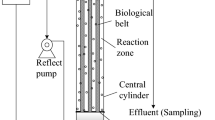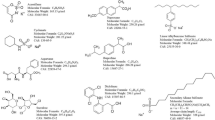Abstract
This study evaluated the behavior of a sequencing batch reactor (SBR) at laboratory-scale in removing the emerging contaminants, ibuprofen (IBP) and methylparaben (MPB), at different concentrations. Individual experiments were carried out for each pollutant and they were divided into six stages of operation, which included starting, load variation, and interim periods of system stabilization. The treated wastewater was synthetic, and it included the pollutions MPB or IBP, glucose as a co-substrate, macronutrients, and micronutrients. The inoculum used to start the reactor was an aerobic sludge from an SBR system used in the treatment of domestic wastewater, which presented with high-content organic material and featured good sedimentation characteristics. The removal percentages of the two compounds at concentrations of 300, 500, and 1000 μg/L were not similar. For MPB, high removal percentages (>96 %) were obtained, while for IBP, decreasing removal percentages were found with increases in analyte concentration, exhibiting average values of 51 ± 15.3, 26 ± 16.6, and 16 ± 5.4 %. Following the removal of IBP, this behavior showed pronounced effects in biomass inhibition during exposure to high concentrations of the pollutant.






Similar content being viewed by others
References
APHA. 2012. Standard methods. For the examination of water and wastewater. 22nd. edited by Eugene W Rice, Rodger B Baird, Andrew D Eaton, and Leonore S Clesceri. Washington: American Public Health Association, American Water Works Association, Water Environment Federation.
Aubert, N., Ameller, T., & Legrand, J. J. (2012). Systemic exposure to parabens: pharmacokinetics, tissue distribution, excretion balance and plasma metabolites of [14C]-methyl-, propyl- and butylparaben in rats after oral, topical or subcutaneous administration. Food and Chemical Toxicology, 50, 445–454.
Ben, W., Qiang, Z., Pan, X., & Chen, M. (2009). Removal of veterinary antibiotics from sequencing batch reactor (SBR) pretreated swine wastewater by Fenton’s reagent. Water Research, 43(17), 4392–402.
Błędzka, D., Gromadzińska, J., & Wąsowicz, W. (2014). Parabens. From environmental studies to human health. Environment International, 67, 27–42.
Canosa, P., Rodríguez, I., Rubí, E., Negreira, N., & Cela, R. (2006). Formation of halogenated by-products of parabens in chlorinated water. Analytica Chimica Acta, 575(1), 106–13.
Carballa, M., Omil, F., Lema, J. M., Llompart, M., García-Jares, C., Rodríguez, I., & Ternes, T. (2004). Behavior of pharmaceuticals, cosmetics and hormones in a sewage treatment plant. Water Research, 38(12), 2918–26.
Carballa, M., Omil, F., & Lema, J. M. (2005). Removal of cosmetic ingredients and pharmaceuticals in sewage primary treatment. Water Research, 39(19), 4790–4796.
Carballa, M., Omil, F., & Lema, J. M. (2007). Calculation methods to perform mass balances of micropollutants in sewage treatment plants. Application to pharmaceutical and personal care products (PPCPs). Environmental Science & Technology, 41(3), 884–90.
Carballa, M., Finkb, G., Omil, F., Lema, J., & Ternes, T. (2008). Determination of the solid–water distribution coefficient (Kd) for pharmaceuticals, estrogens and musk fragrances in digested sludge. Water Research, 42, 287–295.
Collado, N., Buttiglieri, G., Ferrando-Climent, L., Rodriguez-Mozaz, S., Barceló, D., Comas, J., & Rodriguez-Roda, I. (2012). Removal of ibuprofen and its transformation products: experimental and simulation studies. The Science of the Total Environment, 433, 296–301.
Estevez, E., Hernandez-Moreno, J. M., Fernandez-Vera, J. R., & Palacios-Diaz, M. P. (2014). Ibuprofen adsorption in four agricultural volcanic soils. The Science of the Total Environment, 468–469, 406–414.
Fan, C., & Wang, H. C. (2012). Degradation of methyl paraben by the aerated pebble-bed biofilm system. APCBEE Procedia, 1, 299–303.
Ferrando-Climent, L., Collado, N., Buttiglieri, G., Gros, M., Rodriguez-Roda, I., Rodriguez-Mozaz, S., & Barceló, D. (2012). Comprehensive study of ibuprofen and its metabolites in activated sludge batch experiments and aquatic environment. The Science of the Total Environment, 438C, 404–413.
García-Cuerva, L. N. (2010). Nuevas metodologías para la determinación de nonilfenol, sus derivados etoxilados y parabenos en muestras medioambientales. universidad complutense de madrid, 186.
Girardi, C., Nowak, K., Carranza-Diaz, O., Lewkow, B., Miltner, A., Gehre, M., Schäffer, A., & Kästner, M. (2013). Microbial degradation of the pharmaceutical ibuprofen and the herbicide 2,4-D in water and soil—use and limits of data obtained from aqueous systems for predicting their fate in soil. The Science of the Total Environment, 444, 32–42.
González, I., Quintana, J., Rodrıguez, I., & Cela, R. (2011). Evaluation of the occurrence and biodegradation of parabens and halogenated by-products in wastewater by accurate-mass liquid chromatography-quadrupole-time-of-flight-mass spectrometry (LC-QTOF-MS). Water Research, 45, 6770–6780.
Guadarrama, P., Fomine, S., Salcedo, R., & Martínez, A. (2008). Construction of simplified models to simulate estrogenic disruptions by esters of 4-hydroxy benzoic acid (parabens). Biophysical Chemistry, 137(1), 1–6.
Hijosa, M., Matamoros, V., Sidrach, J., Martin-Villacorta, R., Bécares, E., & Bayona, J. (2010). Comprehensive assessment of the design configuration of the constructed wetlands for the removal of pharmaceuticals and personal care products from urban wastewaters. Water Research, 44, 3669–78.
Kosma, C. I., Lambropoulou, D. A., & Albanis, T. A. (2014). Investigation of PPCPs in wastewater treatment plants in Greece: occurrence, removal and environmental risk assessment. The Science of the Total Environment, 466–467, 421–438.
Kumar, A., & Xagoraraki, I. (2010). Pharmaceuticals, personal care products and endocrine-disrupting chemicals in U.S. surface and finished drinking waters: a proposed ranking system. The Science of the Total Environment, 408(23), 5972–5989.
Lin, Y., Ferronato, C., Deng, N., Wu, F., & Chovelon, J. (2009). Photocatalytic degradation of methylparaben by TiO2: multivariable experimental design and mechanism. Applied Catalysis B: Environmental, 88, 32–41.
Londoño, Y. A., Muriel, M., Ospina, N. L., & Peñuela, G. (2014). Implementation and automation of a sequencing batch reactor with a logo-oba6 programmable low-cost controller. Revista Politecnica, 10, 95–103.
Londoño, Y. A., & Peñuela, G. A. (2015). Anaerobic biological treatment of methylparaben in an expanded granular sludge bed (EGSB). Water Science and Technology, 71(11), 1604–1610.
Molina, F., Rodriguez, D. C., & Puerta, B. E. 2008. Manual de laboratorio de procesos biológicos. Universidad de Antioquia. Medellín, 55
Moreno, J., & Buitrón, G. (2002). Optimización de Un Biorreactor Aerobio Para El Tratamietno de Aguas Residuales Industriales. Computación y Sistemas, Número especial:074–082
Quero-Pastor, M. J., Garrido-Perez, M. C., Acevedo, A., & Quiroga, J. M. (2014). Ozonation of ibuprofen: a degradation and toxicity study. The Science of the Total Environment, 466–467, 957–964.
Reif, R., Santos, A., Judd, S., Lema, J., & Omil, F. (2011). Occurrence and fate of pharmaceutical and personal care products in a sewage treatment works. Journal of Environmental Monitoring, 13(1), 137–144.
Serrano, D., Suárez, S., Lema, J., & Omil, F. (2011). Removal of persistent pharmaceutical micropollutants from sewage by addition of PAC in a sequential membrane bioreactor. Water Research, 45(16), 5323–5333.
Soni, M. G., Burdock, G., Taylor, S. L., & Greenberg, N. (2001). Safety assessment of propyl paraben: a review of the published literature. Food and Chemical Toxicology: An International Journal Published for the British Industrial Biological Research Association, 39(6), 513–32.
Soni, M. G., Taylor, S. L., Greenberg, N. V., & Burdock, G. A. (2002). Evaluation of the health aspects of methyl paraben: a review of the published literature. Food and Chemical Toxicology, 40(10), 1335–73.
Suárez, S., Reif, R., Lema, J., & Omil, F. (2012). Mass balance of pharmaceutical and personal care products in a pilot-scale single-sludge system: influence of T, SRT and recirculation ratio. Chemosphere, 89(2), 164–171.
Suresh, S., Tripathi, R., & Gernal, M. N. (2011). Review on treatment of industrial wastewater using sequential batch reactor. International Journal of Science Technology and Management, 2(1), 64–84.
Verlicchi, P., Galletti, A., Petrovic, M., & Barcelo, D. (2010). Hospital effluents as a source of emerging pollutants. Journal of Hydrology, 389, 416–428.
Vo, T. T., Yoo, Y. M., Choi, K. C., & Jeung, E. B. (2010). Potential estrogenic effect(s) of parabens at the prepubertal stage of a postnatal female rat model. Reproductive Toxicology, 29(3), 306–316.
Acknowledgments
The authors would like to thank the GDCON group and the 2014–2015 Sustainability Research Fund of the University of Antioquia for funding this project. English language editing of this manuscript was provided by Journal Prep.
Author information
Authors and Affiliations
Corresponding author
Rights and permissions
About this article
Cite this article
Londoño, Y.A., Peñuela, G.A. Biological Removal of Different Concentrations of Ibuprofen and Methylparaben in a Sequencing Batch Reactor (SBR). Water Air Soil Pollut 226, 393 (2015). https://doi.org/10.1007/s11270-015-2654-5
Received:
Accepted:
Published:
DOI: https://doi.org/10.1007/s11270-015-2654-5




